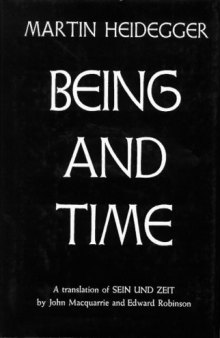دانلود کتاب Being and Time
by Martin Heidegger, John Macquarrie, Edward Robinson|
|
عنوان فارسی: هستی و زمان |
 دانلود کتاب
دانلود کتاب
 جزییات کتاب
جزییات کتاب
مارتین هایدگر در ایران فیلسوفی نام آشناست. گفتهاند که «هستی و زمان» او مهمترین شاهکار فلسفی قرن بیستم است و آن را به بمبی در عالم فلسفه مانند کردهاند. گفتهاند که حتی منتقدانش از تاثیرش در امان نماندهاند. گفتهاند که این کتاب استوارترین ستونهای سنت متافیزیک غرب را به لرزه درمیآورد. اگزیستانسیالیسم، ساختشکنی، هرمنوتیک و الهیات مدرن، فصولی از نظریه و نقد ادبی و هنری، روانکاوی و بسیاری از جنبشهای علوم انسانی معاصر را وامدار این کتاب خواندهاند. به این همه باید آوازه دشواری زبان، طرح شگفتانگیز و ژرفای مضامین آن را نیز افزود. این اوصاف چه بسا راست باشند و چه بسا به گزاف، در هر حال نه تایید و نه انکار آنها گره از کار فروبستهای نمیگشاید. کتابها برای خواندن نوشته میشوند و هستی و زمان را باید خواند. پس از مدتها انتظار، سیاوش جمادی محقق و اندیشمند معاصر کتاب «هستی و زمان» را که یکی از مهمترین و تاثیرگذارترین کتابهای فلسفه قرن است.
Martin Heidegger, father of the study of being, explains that we humans are enmeshed or absorbed in the world in ways that are more fundamental and deeper than our cognitive, intentional, or analytical ways of being; that we move about in the world without consciously guiding each and every step so to speak.
Most of our living and our activity is completely absorbed in the world and is not deliberate or consciously intentional. We find ourselves opening the refrigerator door or arriving at work after a long drive without consciously or thoughtfully guiding our activity at each point along the way. This enmeshed activity is a fundamental way of being that is primary and deeper than our cognitive and intentional states of being.
Further, this way of being in the world is not entirely separate from the world in the way that one engages in detached analysis, studying or analyzing objects and things as through a microscope. Our enmeshed activity shows us, discloses us, as inseparably part of the world and further shows that the world is part of us in very deep and non-cognitive ways.
Why does this insight matter? It matters because thousands of years of philosophical thought have posited humans as rational beings, separate and distinct from the world around us; thinking subjects studying the world of objects as though we lived our everyday lives as detached philosophers and scientists. Heidegger shows us that the world is very much with us; that we are in the world in ways that cannot be extricated from the essence of our being. It is as though the world is a wooden latticework and our lives grow as vines that weave themselves through the lattice and rise to the sun. We have become part of the world and it has become part of us. One cannot rip out the lattice without disrupting the vines. More importantly, the interwoven nature of the vines through the lattice constitutes the most fundamental and primary way of being. All else is but buds on the vine.
And yet, in my opinion, Heidegger misses so much on point and consequently, his analysis is incomplete, and in some cases, this incompleteness evidences an analysis that half reveals and half conceals our actual being in the world.








 این کتاب رو مطالعه کردید؟ نظر شما چیست؟
این کتاب رو مطالعه کردید؟ نظر شما چیست؟
